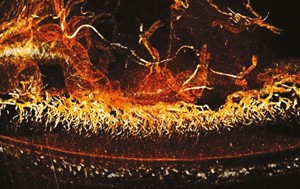
- Select a language for the TTS:
- UK English Female
- UK English Male
- US English Female
- US English Male
- Australian Female
- Australian Male
- Language selected: (auto detect) - EN
Play all audios:
Fireflies light up summer nights using bioluminescence — a mechanism that is well understood from a biochemical point of view, requiring both light-emitting luciferin and oxygen. But how do
fireflies control their oxygen supply, and modify it to fuel flashing in addition to other biological functions? Without a microscopic map of their respiratory system, it has been difficult
to give a definitive answer. Yueh-Lin Tsai and colleagues used X-ray imaging to study the details of the firefly tracheal system and discovered how the oxygen flow is switched on and off.
Using high-resolution images (pictured), Tsai et al. identified the smallest branches of the trachea — the roughly hundred-nanometre-long tracheoles — that are densely packed with
mitochondria, which are organelles supplying energy to the cell. They estimated the oxygen diffusion rates and concluded that during flashing, the activity of the mitochondria is reduced
(most probably by the release of nitric oxide) and thus the oxygen flux needed for bioluminescence is increased. The firefly lantern seems to be optimized for light emission: the flashing
mechanism is very efficient, consuming considerably less energy than flying.
Anyone you share the following link with will be able to read this content:
:max_bytes(150000):strip_icc():focal(319x0:321x2)/people_social_image-60e0c8af9eb14624a5b55f2c29dbe25b.png)

:max_bytes(150000):strip_icc():focal(511x0:513x2)/young-jeezy-909945a4175d43d3899fc8c6241bbf72.jpg)
